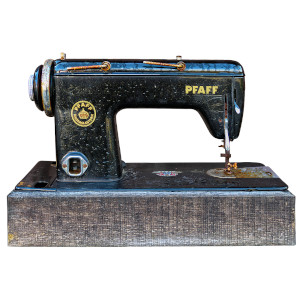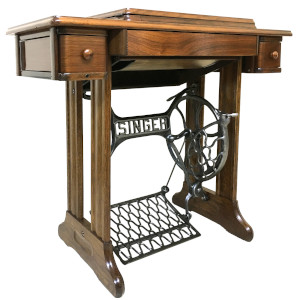We all know what a sewing machine is. You have probably even used one before. You know, it’s the little tabletop machine with the needle your mom used to hem your jeans that were too long or to fix that rip in your dress. And while we are all familiar with the sewing machine, I bet you don’t know exactly how it works.
So, how does a sewing machine work? Well, it is actually a little complicated. There are a lot of moving pieces inside the machine’s housing. Whereas when hand sewing, you pass the needle through the fabric, then pull it out the other side, the way a machine does it is a little trickier.
Two Threads, Not One
 It may look like a sewing machine works only using one thread, but that is simply not true. It would never work. It actually uses a system of double-threaded stitching. Let me try to explain this as simply as I can.
It may look like a sewing machine works only using one thread, but that is simply not true. It would never work. It actually uses a system of double-threaded stitching. Let me try to explain this as simply as I can.
The needle is attached to a thread. When the machine is on, the needle works by puncturing the fabric and knotting the main upper thread with a second thread from the bobbin below. Confused? I bet. It is hard to describe without seeing the process in action.
Basically, after the needle penetrates the fabric, the thread attached to it gets hooked on the “shuttle hook,” which is almost like a gear that loops the main thread and pushes it around in a circular motion so that it creates a knot with the bobbin thread, thereby creating a double stitch.
The top thread weaves overtop, and the bobbin thread weaves on the bottom, and together they make a perfect stitch. This simple mechanism took scientists, many years ago, a very long time to figure out. But when they did, it changed the manufacturing world into what we know today.
The Mechanisms of a Sewing Machine
Your sewing machine works using a complex system of driveshafts, belts, and cranks, all of them powered by a rotating motor to synchronize the needle and the feed dogs that pull the fabric forward to be stitched.
Your average sewing machine uses two drive shafts, two belts, a hand wheel, and a whole lot of spinning. The motor powers a belt, much like the belt in your car’s engine, which turns the handwheel. The handwheel turns the upper drive shaft, which transfers movement to the crank, which moves the needle up and down, and to the secondary belt. The secondary belt then moves the secondary drive shaft that powers the bobbin case and the feed dogs at the bottom of the machine.
Technical mumbo-jumbo, I know. The only way to see how this system really works is to crack open the casing of your sewing machine and watch it in action. Basically, all the drive shafts and belts turn in sync, allowing the top portion of the machine (the needle) and the bottom portion of the machine (the bobbin and feed dogs) to work in perfect harmony.
Stitching Cycle
The total time it takes for one rotation is called a stitching cycle. A stitching cycle is basically one stitch, the time it took for all the spinning inside of the machine to go through one full rotation. A low-end sign machine will work at roughly 600 stitches per minute, which means the machine’s components rotate 600 times in 60 seconds.
For a high-end model, the stitching cycle can happen as many as 1,200 times per minute, resulting in 1,200 stitches in 60 seconds. This is something to look out for when buying a new sewing machine.
How Do I Operate My Sewing Machine?
 If you are fresh to the sewing world, you may not even know how to use the machine. Let’s go through a few simple steps for a beginner.
If you are fresh to the sewing world, you may not even know how to use the machine. Let’s go through a few simple steps for a beginner.
To get your machine set up properly, first, you need to place your spool of thread onto the spool pin, then take the loose end of your thread and weave it through the thread guide, which is located close to the spool pin.
Next, make sure your bobbin is in the right spot and the thread fixed appropriately to the bobbin winder. Then you can mess with the settings, usually with an adjustment dial or digital display, to set your stitch. You may also set the thread tension. Although many of these settings should come pre-programmed on most machines for general purpose sewing.
Assuming your needle is already installed, you can thread the needle manually or use an automatic threader. Now the top part of the machine is ready to go. Pull your bobbin thread from under the bobbin cover, plug in the machine, turn it on, and get sewing!
Final Thoughts: Different Machines, Different Operations
 Even though almost all sewing machines use the same internal mechanism for double-threaded stitching, there are subtle differences. Some machines use a more complicated chain stitch, while other machines use of variation called a lock stitch. But the principle remains the same, using an upper thread and a lower bobbin.
Even though almost all sewing machines use the same internal mechanism for double-threaded stitching, there are subtle differences. Some machines use a more complicated chain stitch, while other machines use of variation called a lock stitch. But the principle remains the same, using an upper thread and a lower bobbin.
There are electric sewing machines, computerized sewing machines, and they come in as many different sizes, specifications, and price ranges as you can imagine. Some sewing machines operate better than others, some sewing machines come with stitching patterns integrated into their internal memory, and some sewing machines are used strictly for embroidery.
That said, they all work using thread to stitch clothing, embroider decorations and blankets, sew giant quilts, and so much more. Some machines are extremely basic and easy to use for a beginner, coming with a few simple knobs and dials to make minimal adjustments.
However, there are a lot of high-end machines that are as customizable as your smartphone. Luckily for you, almost every sewing machine on the market is going to come with a detailed instruction manual to show you how your specific machine works, and how you can use it.
If you are eager to start sewing, just remember to have fun!



